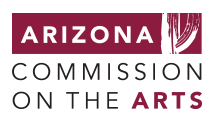A report released today by the Arizona Department of Education and the Arizona Commission on the Arts offers new insights into arts instruction access and participation rates in Arizona schools. Among the findings: as of 2016 only 65% of K-8 students had access to both music and art instruction.
Prepared by Quadrant Research, the Arts Education Data Project Arizona Executive Summary Report features analysis of all available school enrollment data self-reported through the Arizona Department of Education’s SLDS system by schools across the state, both traditional public schools and charter, grades pre-K through 12 for the 2013-14, 2014-15, and 2015-16 school years.
The Data
2,248 schools with a combined student enrollment of 1.1 million are represented in the data.
Additionally, the analysis considers such variables as
- school configuration (Elementary, Middle, or High School),
- school type (traditional public or charter),
- locale (urban, suburban, rural, etc., based on classification codes devised by National Center for Education Statistics),
- number of students who qualify for free and reduced-price lunch.
“This is the most complete picture of the Arts Education landscape we have ever had,” said Dustin Loehr, Director of Arts Education & Title IV-A at the Arizona Department of Education, “As we continue to partner with local education agencies to ensure proper Student Course Enrollment reporting, this picture will become even more clear.”
The data reflect both access (the presence of a course of instruction in at least one arts discipline) and participation (student enrollment).
Key Findings: Access to Arts Instruction
Access is the lowest threshold measure for arts education. It is used to determine if a school offers at least one arts discipline with any student enrollment. This only indicates presence of program, not breadth, and is used primarily to determine where schools may be operating without arts instruction.
- While 82% of all students have access to some arts instruction, only 65% of students in grades K-8 had access to both Music and Art as requirement by state education code during the period covered by the report.
- The number students without access to arts instruction increased 20% between 2015 and 2016.
- The proportion of students without access to any arts courses was greatest in schools where more than 75% of students are eligible to receive Free/Reduced Price.
- Student access to the two required arts disciplines (Art and Music) for elementary and middle schools (K-8) is lowest in schools where more than 75% of students receive Free/Reduced Price Lunch (62%).
- While Public Schools represent 84% of the population they represent 80% of the “no arts” student population whereas Charter Schools represent 16% of the overall student population they hold 20% of the “no arts” students.
Key Findings: Participation in Arts Instruction
- 68% of all students (nearly 750,000) participated in arts education courses.
- Music and Art are the most widely available of the arts disciplines and have the highest participation rates—47% and 50%, respectively—among the five artistic disciplines.
- Student participation varies only slightly between Traditional schools and Charter schools. In traditional schools, 68% of students are enrolled in the arts as compared to 65% for Charter schools
The full Executive Summary Report can be found at https://azarts.gov/azartsed-explorer/.
Among those taking a close look at the picture presented by the report is Catherine “Rusty” Foley, Executive Director of Arizona Citizens for the Arts, a statewide advocacy network that partnered with AZ DOE and the Arts Commission to sponsor the research with funding from Americans for the Arts.
“While the results of this study demonstrate that many Arizona students are receiving a rich arts education in our K-12 schools, they also challenge us to work to ensure that all Arizona students have an equitable chance at an arts education,” Foley observed. “For example, in 2015-2016 nearly a third of our K-8 students were not receiving the required instruction in visual arts and music, and the student access is lowest in those K-8 schools where more than 75% of students receive Free/Reduced Price Lunch. Given the remarkable impact of an arts education on academic achievement, student engagement and improved self-image, we must make sure that every Arizona student reaps the benefits of a quality arts education.“
The Data Explorer Dashboard
Beyond the Executive Summary Report, Arizonans can explore the data through an easy-to-use interactive online dashboard at https://azarts.gov/azartsed-explorer/. With intuitive controls and myriad visualization options, this powerful tool allows users to venture deep into the data, following whatever path they choose, including statewide geographic comparisons; county-, district-, and school-level reporting, and year-over changes in enrollment, to name just a few.
According to Elisa Radcliffe, the Arts Commission’s Arts Learning Manager, “This tool provides a picture of where Arizona’s schools currently stand, allowing school leaders, parents and advocates to ensure that every child in Arizona can participate in the arts.”






